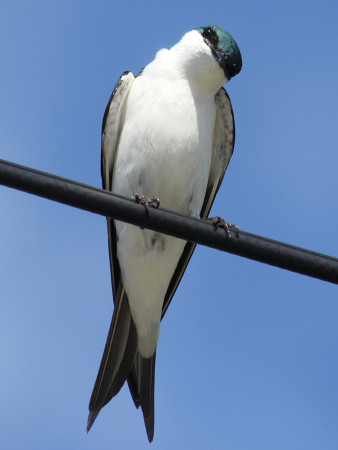
Maya Wilson is a graduate student at Virginia Tech researching the ecology and life history of the Bahama Swallow, an endangered species endemic to the Bahamas. She is one of the dedicated young scholars who was awarded the BirdsCaribbean David S. Lee Fund Grant and her work is critical to understanding the Bahama Swallow and informing conservation strategies. Here, she discusses her research and describes her exciting field experiences with this unique species.
As we exit the truck, I hear a series of aggressive clicks and feel a rush of air as a wing brushes only a couple inches from my head.
When the Bahama Swallows began breeding, we started watching this particular area intensely, suspecting that the large, still-standing dead pine tree (i.e. pine snag) only a few paces from the old logging road would be a choice spot for a pair of swallows to make their nest. Sure enough, a couple weeks ago we found three white eggs. We are now scheduled to come back to see if those three eggs have hatched, and the parents are obviously well aware of that.
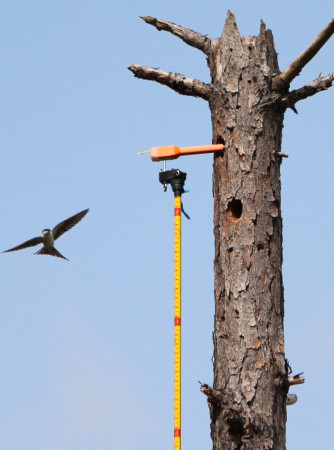
The bird that dove at my head joins its mate on a small exposed branch in a nearby tree and they chatter to each other, seeming to make a plan, before taking off again to resume their “attack.” It is hard to resist the urge to duck as I watch the male turn toward me and dive again, this time straight at my face. However, just like every other time, he changes direction at the last possible second — a signature move of a swallow. In reality, these small (~15 g) birds can’t hurt us.
The three of us walk to the back of the truck and begin to assemble the “peeper” camera so that we can take a closer look. Using several specialized pieces of hardware, we attach the camera to a large extension pole. I hoist the apparatus onto my shoulder to keep it steady, carefully climb over the pile of loose limestone along the road, and circle around to the other side of the snag. The nest is inside a hole (i.e. cavity) about 31 feet (9.4 meters) up, making this one of the highest nests we have studied, and therefore one of the hardest to observe.
I turn the camera on, and Mel confirms that it is wirelessly sending images to the monitor she is holding. I begin hoisting the pole upward, locking each section into place. Finally, the camera is near the correct height, and Shannan, who is standing back so that she has a good vantage point, guides me until it slips into the nesting cavity.
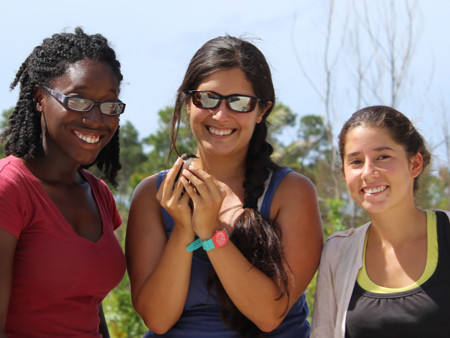
“Two chicks!” Mel shouts, and then, “wait, the last egg is hatching!” There is a bustle of activity as we all try to look at the small screen to see what is happening in the nest. Sure enough, the last egg has a crack down the middle, and a nestling is trying to fight its way out to join its two siblings in the nest.
We record a short video and then I bring the camera down. We all head back to the truck, disassemble the camera, and pile back in while the adult swallows take turns making sure that their newly hatched nestlings are okay. We have to try our hardest to disturb the nest as little as possible, so we decide to leave this family alone for a few days.
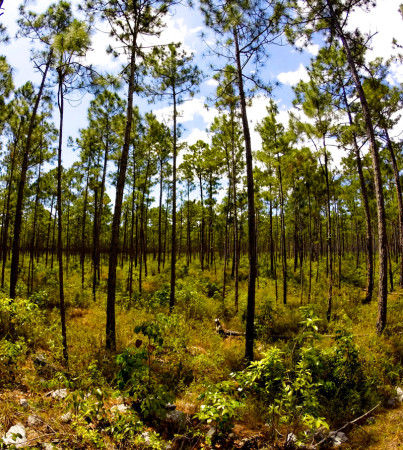
The memory of watching a Bahama Swallow nestling hatch during the summer of 2016 will stick with me for the rest of my life. I am back on Great Abaco Island again in 2017, and for the third field season in a row our team will be made up of three women in their twenties. Dressed in worn-out field clothes and carrying our peeper camera and other equipment through the forest, we certainly get our fair share of confused stares. But we spend several months of the year in the northern Bahamas for a reason. Great Abaco, Grand Bahama, Andros and New Providence are the only islands within the more than 700 islands that make up the Bahama Archipelago that contain large areas of the native Caribbean pine (Pinus caribaea bahamensis). This is why these three islands have rightfully earned the nickname, “pine islands.”
These pine forests are home to many birds, including five of the six Bahamian endemic species. One of these endemic species is the endangered Bahama Swallow (Tachycineta cyaneoviridis), which has only ever been found to breed on the pine islands. This bird, along with many other Caribbean endemics, is severely understudied.
My graduate research focuses on three main areas, with the overarching goal of providing information that is relevant to the species’ conservation to my main collaborator, the Bahamas National Trust, as well as other local organizations.
(1) How many Bahama Swallows are left, how are they spread across the pine islands, and do birds on the different islands breed with each another?
There have only been a few official estimates of Bahama Swallow population levels over the past 30 years, and they indicate a rather dramatic decline. The IUCN Red List estimates a current population of 1500-4000 individuals. Using multiple survey techniques, I hope to provide a more precise estimate that will shed some light on overall species abundance and whether Bahama Swallows favor certain habitats or islands in general. Using genetic information, we can determine whether the species has become separated into smaller, isolated populations, which would have significant implications for the survival of the Bahama Swallow and subsequent conservation management plans.
(2) When and where do Bahama Swallows breed, and how successful are each of their nesting attempts?
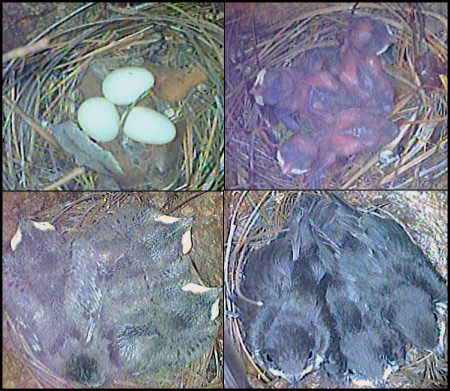
Bahama Swallows are obligate secondary cavity-nesters, meaning that they will only build nests inside a cavity; however, they do not have the ability to create that cavity themselves. Rather, they rely on natural processes or other excavating species to create cavities for them. In 1995, Allen (1996) conducted a study that revealed important information about Bahama Swallow breeding biology and behavior. The swallows breed between April and July, laying an average of three eggs in abandoned woodpecker cavities in pine snags and various other cavities. By locating swallow nests in all cavity types, and then monitoring those that we can safely access, we hope to provide additional information on the determinants and limitations to the breeding biology of the species.
(3) Is breeding habitat limited? How do Bahama Swallows interact with other cavity-nesting species in the same habitat?
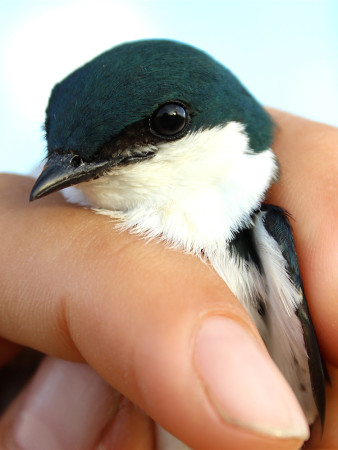
Almost all of the forest on the pine islands is secondary growth, the result of extensive logging that took place from 1905-1969. It still is not clear what effects the logging and subsequent disturbances (e.g., fire and hurricanes) have had on the structure of the pine forest or the surrounding habitats, and on the species that inhabit them. The Hairy Woodpecker (Leuconotopicus villosus) is present on all of the pine islands, and is closely associated with the pine forest, although it can be found in other habitats. In The Bahamas, the larger West Indian Woodpecker (Melanerpes superciliaris) is mostly limited to Great Abaco, where it is mostly associated with dry broadleaf “coppice” and human habitation. The swallows and other secondary cavity-nesters rely on these woodpeckers to create cavities for them. However, the availability of cavities and the competition for those cavities may vary between habitats (e.g., pine forest vs. towns). We can look at these interactions by assessing the availability of nesting resources and documenting nests of all cavity-nesting species.
My research has come a long way since it began in 2014, though there is still much to accomplish. My team and I continue to unravel the ecology and biology behind the pine islands and their Bahama Swallows, and are currently getting our 2017 field season underway. I look forward to keeping the BirdsCaribbean community updated as the project progresses and am excited to meet more of you at the Cuba Conference this July.
Maya is a PhD Candidate at Virginia Tech. To learn more about the Bahama Swallow research and team, please visit please this website. Maya’s research is funded by BirdsCaribbean David S. Lee Fund, The Rufford Foundation, IDEA WILD and Golondrinas de las Américas.
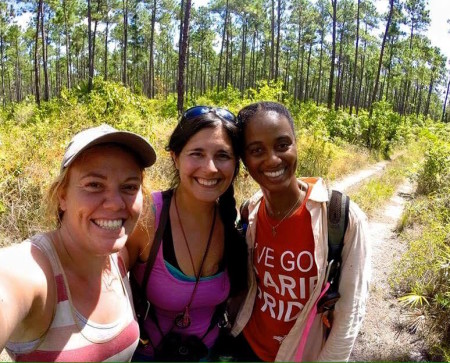

One comment
Comments are closed.